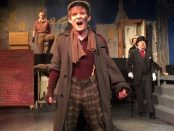Pilobolus: Summer 2024 Season
"Memory" brought back “Untitled,” a masterpiece from 1978. This work had everything that made Pilobolus the world class dance troupe it became. Choreographed by Pilobolus founders Robby Barnett, Alison Chase, Martha Clarke, Moses Pendleton, Michael Tracy and Jonathan Wolken, and using disarmingly and misleadingly pleasant music by Robert Dennis, “Untitled” began with two women (Feliz and Klinkman) wearing ornate 19th century dresses as they lay on the ground having a pleasant picnic. (Costumes by Kitty Daly and Malcolm McCormick.) As they rose they slowly grew into giants, their legs clearly those of men. These now eight-foot tall women moved gracefully about soon joined by two fully dressed men (Loman and Langford) who flirt with them. As the two ladies were lowered onto their own legs, their supporters proved to be two naked men (Chaparro and Ellis), a bit of a shock to the audience, softened by the beauty of the two. The two women wafted about blissfully unaware of the four men until the naked men resumed their positions under the women’s skirts as they floated off. This combination of period nicety, nudity and psychology and superb movement made for a hauntingly memorable work. [more]


